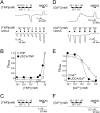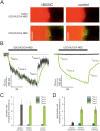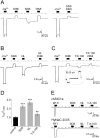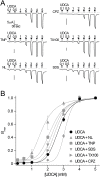The bile acid-sensitive ion channel (BASIC) is activated by alterations of its membrane environment
- PMID: 25360526
- PMCID: PMC4216111
- DOI: 10.1371/journal.pone.0111549
The bile acid-sensitive ion channel (BASIC) is activated by alterations of its membrane environment
Abstract
The bile acid-sensitive ion channel (BASIC) is a member of the DEG/ENaC family of ion channels. Channels of this family are characterized by a common structure, their physiological functions and modes of activation, however, are diverse. Rat BASIC is expressed in brain, liver and intestinal tract and activated by bile acids. The physiological function of BASIC and its mechanism of bile acid activation remain a puzzle. Here we addressed the question whether amphiphilic bile acids activate BASIC by directly binding to the channel or indirectly by altering the properties of the surrounding membrane. We show that membrane-active substances other than bile acids also affect the activity of BASIC and that activation by bile acids and other membrane-active substances is non-additive, suggesting that BASIC is sensitive for changes in its membrane environment. Furthermore based on results from chimeras between BASIC and ASIC1a, we show that the extracellular and the transmembrane domains are important for membrane sensitivity.
Conflict of interest statement
Figures










Similar articles
-
Bile acids potentiate proton-activated currents in Xenopus laevis oocytes expressing human acid-sensing ion channel (ASIC1a).Physiol Rep. 2017 Feb;5(3):e13132. doi: 10.14814/phy2.13132. Physiol Rep. 2017. PMID: 28193786 Free PMC article.
-
Activation of the Human Epithelial Sodium Channel (ENaC) by Bile Acids Involves the Degenerin Site.J Biol Chem. 2016 Sep 16;291(38):19835-47. doi: 10.1074/jbc.M116.726471. Epub 2016 Aug 3. J Biol Chem. 2016. PMID: 27489102 Free PMC article.
-
A Cytosolic Amphiphilic α-Helix Controls the Activity of the Bile Acid-sensitive Ion Channel (BASIC).J Biol Chem. 2016 Nov 18;291(47):24551-24565. doi: 10.1074/jbc.M116.756437. Epub 2016 Sep 27. J Biol Chem. 2016. PMID: 27679529 Free PMC article.
-
The bile acid-sensitive ion channel (BASIC), the ignored cousin of ASICs and ENaC.Channels (Austin). 2014;8(1):29-34. doi: 10.4161/chan.27493. Epub 2013 Dec 23. Channels (Austin). 2014. PMID: 24365967 Free PMC article. Review.
-
ASIC and ENaC type sodium channels: conformational states and the structures of the ion selectivity filters.FEBS J. 2017 Feb;284(4):525-545. doi: 10.1111/febs.13840. Epub 2016 Sep 15. FEBS J. 2017. PMID: 27580245 Review.
Cited by
-
Aspirin locally disrupts the liquid-ordered phase.R Soc Open Sci. 2018 Feb 28;5(2):171710. doi: 10.1098/rsos.171710. eCollection 2018 Feb. R Soc Open Sci. 2018. PMID: 29515878 Free PMC article.
-
COVID-19 and Diarylamidines: The Parasitic Connection.Int J Mol Sci. 2023 Apr 1;24(7):6583. doi: 10.3390/ijms24076583. Int J Mol Sci. 2023. PMID: 37047556 Free PMC article. Review.
-
Bile acids potentiate proton-activated currents in Xenopus laevis oocytes expressing human acid-sensing ion channel (ASIC1a).Physiol Rep. 2017 Feb;5(3):e13132. doi: 10.14814/phy2.13132. Physiol Rep. 2017. PMID: 28193786 Free PMC article.
-
Isoform-specific Inhibition of N-methyl-D-aspartate Receptors by Bile Salts.Sci Rep. 2019 Jul 11;9(1):10068. doi: 10.1038/s41598-019-46496-y. Sci Rep. 2019. PMID: 31296930 Free PMC article.
-
Mechanistic Understanding from Molecular Dynamics in Pharmaceutical Research 2: Lipid Membrane in Drug Design.Pharmaceuticals (Basel). 2021 Oct 19;14(10):1062. doi: 10.3390/ph14101062. Pharmaceuticals (Basel). 2021. PMID: 34681286 Free PMC article. Review.
References
-
- Kellenberger S, Schild L (2002) Epithelial sodium channel/degenerin family of ion channels: a variety of functions for a shared structure. Physiol Rev 82: 735–767. - PubMed
-
- Jasti J, Furukawa H, Gonzales EB, Gouaux E (2007) Structure of acid-sensing ion channel 1 at 1.9 Å resolution and low pH. Nature 449: 316–323. - PubMed
-
- Wiemuth D, Sahin H, Falkenburger BH, Lefevre CM, Wasmuth HE, et al. (2012) BASIC - A bile acid-sensitive ion channel highly expressed in bile ducts. FASEB J 26: 4122–4130. - PubMed
Publication types
MeSH terms
Substances
LinkOut - more resources
Full Text Sources
Other Literature Sources

